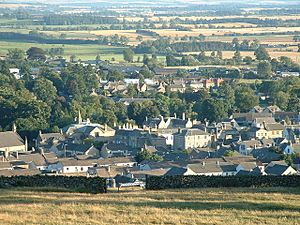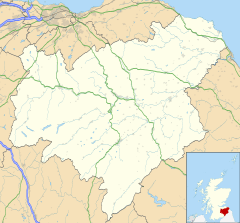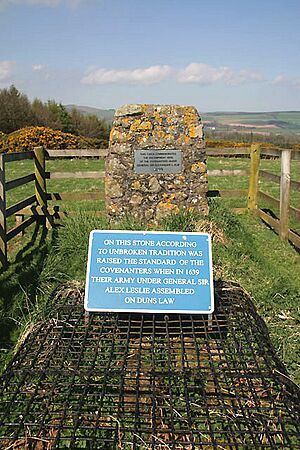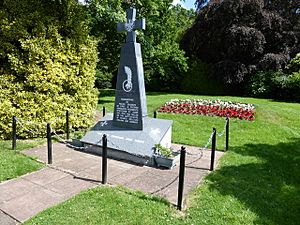Duns, Scottish Borders facts for kids
Quick facts for kids Duns |
|
|---|---|
 Duns from Duns Law |
|
| Population | 2,820 (2020) |
| OS grid reference | NT786539 |
| Council area | |
| Lieutenancy area | |
| Country | Scotland |
| Sovereign state | United Kingdom |
| Post town | Duns |
| Postcode district | TD11 |
| Dialling code | 01361 |
| Police | Lothian and Borders |
| Fire | Lothian and Borders |
| Ambulance | Scottish |
| EU Parliament | Scotland |
| UK Parliament |
|
| Scottish Parliament | |
Duns is a lively town located in the Scottish Borders area of Scotland. It used to be the main town, also known as the county town, for the historic area of Berwickshire. Today, Duns is a hub for shopping and local services in the region.
Contents
Exploring Duns: A Look at its Past
Ancient Times in Duns
The area around Duns has been home to people for a very long time. On top of Duns Law, a hill near the town, you can still see the remains of an Iron Age hillfort. This was a strong, walled settlement built by ancient people. Other similar structures nearby, like the one at Edin's Hall Broch, show that people lived and defended themselves here many centuries ago.
Duns in the Middle Ages
The first time Duns was mentioned in writing was before 1179. A person named 'Hugo de Duns' was a witness to an important document. Later, in 1296, 'Robert of Douns' signed the Ragman Roll, a list of Scottish nobles who promised loyalty to the King of England.
The first Duns Castle was built in 1320 by the Earl of Moray. He was the nephew of the famous Scottish king, Robert the Bruce. The town was often attacked by the English because it was close to the border. In 1318, Scottish leaders met in Duns Park before they successfully took back the town of Berwick from the English. In 1333, a Scottish army gathered in Duns to march on Berwick, but they were badly beaten at the Battle of Halidon Hill.
A famous event happened in 1377, known as the Battle of Duns. The English army, led by the Earl of Northumberland, was camped near Duns. At night, the townspeople used rattles to scare birds from their crops. This noise startled the English army's horses, causing chaos. The confused English soldiers were then defeated by the brave townsfolk! This event is why Duns has its motto: Duns Dings A! This means "Duns beats all!"
In 1513, about 6 miles (10 km) north of Duns, King James IV of Scotland gathered his army. They were preparing for a campaign that led to the terrible Battle of Flodden.
Duns in More Recent History
In 1490, Duns was given the special status of a Burgh of Barony by King James IV. This meant the townspeople could hold a market every Wednesday and a week-long fair once a year. However, Duns suffered greatly from fighting and raids across the border. It was burned down three times in just 14 years (1544, 1545, and 1558) during a conflict called the Rough Wooing.
By 1588, the town had moved from the top of Duns Law to where it is today, at the foot of the hill. The ruined original site of the town is now known as the Bruntons, which comes from "Burnt-town."
In 1639, during the First Bishops' War, Duns became a gathering place for the Covenanting army. This army, led by General Leslie, was preparing to face King Charles I of England's English army. General Leslie stayed in Duns Castle and ordered a small fort, called a redoubt, to be built on Duns Law. The two armies did not fight. Instead, they signed a peace agreement called the Pacification of Berwick. You can still see the remains of Leslie's fort on Duns Law today.
After the Battle of Dunbar in 1650, Oliver Cromwell placed soldiers in Duns.
Over time, Duns grew and became more important. Many of the administrative tasks for Berwickshire were handled in the town. In 1903, Duns was officially confirmed as the county town of Berwickshire. This meant it was the main town for local government and courts.
Duns used to have a building called a Tolbooth in its Market Square. This was like a town hall and was used for town administration and dealing with lawbreakers. The last Tolbooth building was built in 1816 and was used until it was taken down in 1966.
Duns as the County Town
After Berwick-upon-Tweed became part of England in 1482, Duns and another town called Lauder shared the role of county town for a while. This meant they both hosted the local court. In 1596, Greenlaw became the official county town. However, Duns became the county town again in 1661, but then lost it back to Greenlaw in 1696.
By the mid-1800s, Duns was seen as a more important town than Greenlaw. So, in 1853, a law was passed that allowed courts and other important meetings to be held in Duns. The County Buildings were built in Duns in 1856 for these purposes.
When elected county councils were created in 1890, the Berwickshire County Council decided to hold its meetings in Duns. So, the County Buildings in Duns became the main office for the county council. In 1903, a new law finally made Duns the official county town for all purposes. The County Buildings served as the headquarters for Berwickshire County Council until 1975.
Duns Today
Duns offers the best shopping in a 15-mile (24 km) area. While it no longer has the main offices for the Scottish Borders Council, it still has a Registry Office.
Since the early 1990s, many new homes have been built in and around Duns. A new, modern Berwickshire High School opened in 2009, replacing the older buildings. The old high school is now being turned into a primary school.
Duns Castle
Duns Castle is a beautiful building with a Gothic Revival style. Before this, it was a strong Peel tower built in 1320 by the Earl of Moray. He was given the land by King Robert I.
Grand Country Houses Nearby
The area around Duns is home to several impressive country houses. Some of these include:
- Manderston House, an Edwardian mansion rebuilt in 1903.
- Edrom House, an early 18th-century home.
- Blanerne Castle, an ancient family home rebuilt in 1895, with a ruined medieval tower nearby.
- Nisbet House, built around 1630, now a family home.
- Wedderburn Castle, built between 1771 and 1775 by famous architects Robert and James Adam.
- Kimmerghame House, a large Scottish Baronial mansion rebuilt in 1851.
The Jim Clark Motorsport Museum
Duns is proud to host the Jim Clark Motorsport Museum. Jim Clark was a famous racing driver who lived on a farm nearby. He was a Formula 1 World Champion in 1963 and 1965, winning 25 Grand Prix races! The museum opened in 2019 and shows off his Lotus race car, a rally car, his racing overalls, and over 100 trophies. You can also see many old newspapers, books, magazines, and films about his amazing career.
Polish War Memorial
During the Second World War, many Polish soldiers came to the Scottish Borders. They formed new army groups before going to fight in Europe. Duns and the surrounding area were home to the First and Second Armoured Regiments of the Polish Army. They practiced their tank skills on the moors of Berwickshire.
A special monument was built in Duns to honor the 127 men from these regiments who died in the war. Polish ex-soldiers and the people of Duns worked together to pay for it. It was officially revealed in 1981 by their former leader, General Maczek.
There is also a memorial in the Market Square to Wojtek. Wojtek was a Syrian brown bear adopted by the Polish army in 1943! The memorial was a gift from Duns' twin town, Żagań in Poland, and was unveiled in 2016.
Getting Around Duns
Duns used to have a railway connection, but it closed to passengers in 1951 and to goods in 1966.
Two main roads pass through the town:
- The A6105 goes from west to east, connecting Earlston to Berwick on Tweed.
- The A6112 goes from south to north, connecting Coldstream to Grantshouse.
The town is served by regular bus services, connecting it to places like Galashiels, Berwick-upon-Tweed, Eyemouth, and Chirnside.
Media and News
Local news and TV shows for Duns are provided by BBC Scotland and ITV Border. You can also listen to local radio stations like BBC Radio Scotland and Greatest Hits Radio Scottish Borders and North Northumberland. The local newspapers for the town are the Border Telegraph and the Southern Reporter.
Education in Duns
Duns primary school, which used to be in an old Victorian building, moved to new, improved premises in the old Berwickshire High School building in 2017. The new Berwickshire High School opened in 2009. It is located west of the town and provides education for students from Duns and many surrounding villages. Borders College also has a small campus in the town, offering further education.
The Ba Game of Duns
The "Ba game" is a type of traditional medieval football played in Duns. For this game, three special balls, or "Bas," were needed: one gold, one silver, and one colored. A fourth ball was kept ready in case of any problems.
At midday, the honor of throwing up the first ball was auctioned off. The ball was usually thrown by a member of the Duns Castle family. The game started at 1 o'clock in the Market Square. The goal for the married men was the church pulpit. If they scored, the church bell would ring! The goal for the bachelors was the hopper of any grinding mill in the area, which was over a mile away. If a bachelor won the Ba, he would be dusted with flour and given a meal of pork and dumplings by the miller.
This fun game was brought back in 1949 as part of the Duns Summer Festival. Now, the goals are at opposite corners of the Market Square. The "Ba game" (also known as Hand Ba') is played in other places in the Scottish Borders too, like Jedburgh and Denholm.
Famous People from Duns
Many notable people have connections to Duns, including:
- Sir Whitelaw Ainslie (1767–1837), a surgeon and writer.
- Louise Aitken-Walker (born 1960), a racing driver.
- Reverend Thomas Boston (1676–1732), a theologian.
- John Black (1783–1855), a journalist and editor.
- Robert Fortune (1812–1880), a botanist who brought tea from China to India.
- Pat Nevin (born 1963), a Scottish international football player.
- Blessed John Duns Scotus (around 1266 – 1308), a famous theologian and scholar.
- Jim Clark, the famous Formula 1 World Champion (mentioned above).
Twin Towns
Duns is twinned with:
Images for kids









